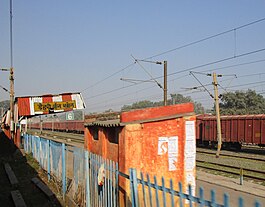Gaya–Mughalsarai section
| Gaya–Mughalsarai section including Arrah–Sasaram and Son Nagar–Barkakana branch lines | |||
|---|---|---|---|
 Dehri-on-Sone railway station lies on Gaya–Mughalsarai section | |||
| Overview | |||
| Status | Operational | ||
| Owner | Indian Railways | ||
| Locale | Bihar, Jharkhand, Uttar Pradesh | ||
| Termini | Gaya Mughalsarai | ||
| Stations | 31 | ||
| Service | |||
| Operator(s) | East Central Railway | ||
| History | |||
| Opened | 1907 | ||
| Technical | |||
| Line length | 197 km (122 mi) | ||
| Number of tracks | 2 | ||
| Track gauge | 5 ft 6 in (1,676 mm) broad gauge | ||
| Electrification | electrified in 1962 | ||
| Operating speed | up to 160 km/h (99 mph) | ||
| |||
The Gaya–Mughalsarai section is a railway line connecting Gaya and Mughalsarai. This 197-kilometre (122 mi) track is part of the Grand Chord, Howrah–Gaya–Delhi line and Howrah–Allahabad–Mumbai line. This section includes Arrah-Sasaram and Son Nagar branch lines. It is under the jurisdiction of East Central Railway.
Grand Chord[edit | edit source]
Ever since the railway connection of Delhi with Howrah in 1866, the East Indian Railway Company was making regular efforts to reduce the distance of the Howrah–Delhi main line. After a survey in 1888-89 and two more subsequently, a route was determined from Dhanbad to Mughal Sarai via Koderma and Gaya. The major works in this section were a bridge across the Son River at Dehri, and tunnelling and ghat line construction between Gurpa and Gujhandi.[1] The Grand Chord was opened in 1907. Even when the Grand Chord was under construction, the Son Nagar-Daltonganj branch line was opened in 1902.[2]
Bridging the Soane/Son[edit | edit source]
The total length of the Upper Sone Bridge across the Soane, as the river was then called, over abutments is 3,064 metres (10,052 ft).[3] It was opened for traffic on 27 February 1900. When it was built, it was the longest bridge in India and was believed to be the second longest bridge in the world, short of the Tay Bridge near Dundee.[1][3] Subsequently, longer road bridges were built but it remained the longest rail bridge in India for many years.[4] The opening of the 4.62 km Vembanad Rail Bridge, connecting the Container Transshipment Terminal on Vallarpadam Island to Edappally, in February 2011, pushed it to the second position.[5][6]
Electrification[edit | edit source]
The Gaya–Mughalsarai section was electrified in 1962.[2] In 1965, Asansol–Bareilly Passenger was the first long-distance train on Eastern Railway hauled by an AC loco.[7]
Arrah–Sasaram[edit | edit source]
The Arrah–Sasaram line was opened as a narrow gauge (2 ft 6 in (762 mm)) section of Martin's Light Railways in 1914 and was closed in 1978.[2][8] A new broad-gauge line was laid by Indian Railways from Sasaram to Arrah in 2006–07.[9]
Speed limits[edit | edit source]
Most of the Gaya–Mughalsarai section is classified as 'A' class line where trains can run up to 160 km per hour but in certain sections speeds may be limited to 120–130 km per hour. The Howrah Rajdhani (between Howrah and New Delhi) travels at an average speed of 85.8 km per hour and the Sealdah Rajdhani (between Sealdah and New Delhi) travels at an average speed of 84.70 km per hour.[10][11]
Freight corridor[edit | edit source]
Son Nagar is expected to be connected with Ludhiana as part of the Eastern Corridor. The primary feeder routes for this will be from Sonnagar to Durgapur via Gomoh, Sonnagar to Tatanagar via Garhwa Road, and Barkakana to Bokaro via Chandrapura.[12]
Railway reorganisation[edit | edit source]
In 1952, Eastern Railway, Northern Railway and North Eastern Railway were formed. Eastern Railway was formed with a portion of East Indian Railway Company, east of Mughalsarai and Bengal Nagpur Railway. Northern Railway was formed with a portion of East Indian Railway Company west of Mughalsarai, Jodhpur Railway, Bikaner Railway and Eastern Punjab Railway. North Eastern Railway was formed with Oudh and Tirhut Railway, Assam Railway and a portion of Bombay, Baroda and Central India Railway.[13] East Central Railway was created in 1996–97.[14]
References[edit | edit source]
- ↑ 1.0 1.1 "As the traffic continued to grow even beyond the capacity of the". Tripod. Retrieved 20 November 2011.
- ↑ 2.0 2.1 2.2 Saxena, R. P. "Indian Railway History Time line". Irse.bravehost.com. Archived from the original on 29 February 2012. Retrieved 15 March 2017.
- ↑ 3.0 3.1 O'Malley, L. S. S. Bihar and Orissa Gazetteers Sahabad. p. 166, Dehri. ISBN 9788172681227. Retrieved 25 June 2011.
- ↑ "Longest Railway Bridge in India". Colours of India. Retrieved 25 June 2011.
- ↑ "A bridge over Vembanad Lake". The Hindu. Retrieved 25 June 2011.
- ↑ "Longest railway bridge in Kochi". ForumCo.com. Archived from the original on 23 March 2012. Retrieved 25 June 2011.
- ↑ "IR History Part IV (1947–1970)". IRFCA (Indian Railways Fan Club). Retrieved 20 November 2011.
- ↑ "Non-IR Railways in India". IRFCA. Retrieved 1 December 2011.
- ↑ "Speech of Shri Lalu Prasad Introducing the Railway Budget 2006-07 On 24th February 2006". New lines. Press Information Bureau. Retrieved 1 December 2011.
- ↑ "Permanent Way". Track Classifications. Retrieved 15 January 2012.
- ↑ "Trivia". Highest speed sections of track. Retrieved 15 January 2012.
- ↑ "Freight Trains". What is dedicated freight corridor?. IRFCA. Retrieved 20 November 2011.
- ↑ "Geography – Railway Zones". IRFCA. Retrieved 28 March 2014.
- ↑ "East Central Railway". ECR. Archived from the original on 12 January 2014. Retrieved 28 March 2014.
|